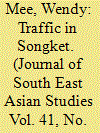|
|
|
Sort Order |
|
|
|
Items / Page
|
|
|
|
|
|
|
| Srl | Item |
| 1 |
ID:
095567


|
|
|
|
|
| Publication |
2010.
|
| Summary/Abstract |
This paper uses the example of songket to explore translocal Malay cultural processes in Sambas, West Kalimantan. I argue these intra-Malay cultural exchanges reframe selected Sambas Malay cultural forms as Malay 'cultural heritage', making it difficult to view cultural practices in purely localised terms. Consequently, many cultural forms lose their localised normative values and become aspects of a wider cultural heritage to be preserved, performed and consumed. The paper begins with a discussion of the historical, political and social grounds that forge a sense of translocalism amongst many Sambas Malays. Building on this, the more specific interest in participating in intra-regional Malay cultural exchanges is explained with reference to commodification, internationalisation and institutionalisation.
|
|
|
|
|
|
|
|
|
|
|
|
|
|
|
|
| 2 |
ID:
089378


|
|
|
|
|
| Publication |
2009.
|
| Summary/Abstract |
The horrific violence that has marred Indonesia's 'transition to democracy' raises numerous disconcerting questions; not least of which is how future interested actors or governments - central and regional alike - will tackle these atrocities in a historical framework. How should a series of historical events, such as the killing of thousands of Indonesians by Indonesians be (un)officially remembered? Two paintings that hang in Sambas, West Kalimantan's most prominent cultural centrepiece, the Alwadzi Koebillah kraton, are remarkable, for they give us a glimpse as to how local voices might attempt to possess the historical meanings and readings of Indonesia's recent ethnic strife. Perhaps one of a kind in Indonesia, these paintings boldly portray the bloody battles that took place in Sambas in early 1999, pitting the 'courageous' and 'youthful' Malays of Sambas against the 'middle-aged' and 'treacherous' Madurese. These depictions make it abundantly clear that, through this bloodletting, Sambas Malays awoke from their slumber in time to mobilise, to confront and to defeat their nemesis. As an ethnopolitical force, the glorious rise of 'Malay' is unmistakable. The broader political context in which these paintings were commissioned, however, invests them with greater significance. Only in a decentralised state, one distinct from the excessive centralism of the New Order, would the (semi) public display of these heroic memorials to local, i.e. non-national, violence be made possible.
|
|
|
|
|
|
|
|
|
|
|
|
|
|
|
|
|
|
|
|
|